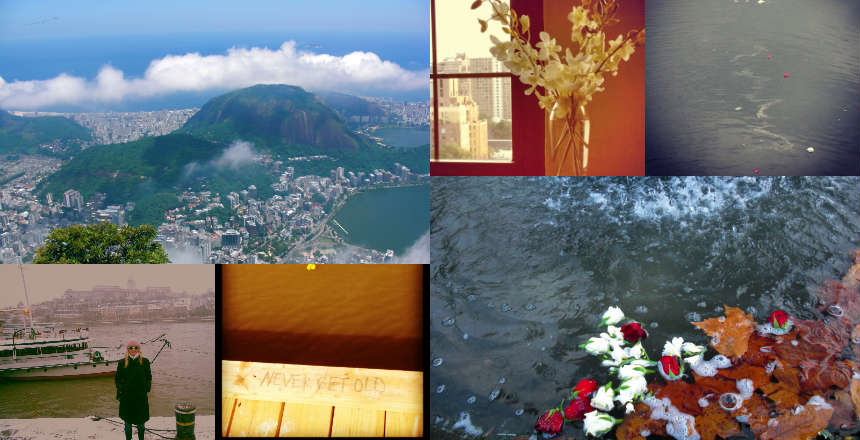Within hours of my 40-year-old husband’s fatal heart attack in 2009, it dawned on me that I would have to honor his cremation wishes. Actually, my words to his best friend were slightly less respectful: “Oh fuck, Alberto’s gonna make me cremate him.”
At 34 years old, I’d attended more than 30 funerals but the decision whether to bury or cremate had always fallen to someone else. Even as I heard myself saying “cremation” to the funeral director, my widow brain was already panicking about the deathiversaries and birthdays ahead. I was used to releasing my grief through visits to cemeteries or crash sites. What sort of ritual could be had if your husband died in the bed you shared and his ashes reside in your apartment?
The ritual found me a few months later. My suitcase was open, and I was attempting to pack for the annual Fourth of July trip we had always taken to Lake Winnipesaukee. A favorite cousin was accompanying me, but I felt overwhelmed about visiting Alberto’s “happy place” without him. It could have been the close proximity of my suitcase to his urn or the six-pack my cousin and I had consumed, but I suddenly realized I could take Alberto with me.
I brought a few tablespoons of him to spread on the lake and a few more to Miami, his birthplace, a month later. Since then, I’ve spread his ashes in the Bahamas, Brazil, Connecticut, Cuba, England, Hungary and Texas. Trial, error and variables like wind have culminated in a list that I hope spares you the learning curve.
1. There will be bones. When I unscrewed the urn containing Alberto’s ashes, I expected a small box of soft campfire ash. I encountered a plastic bag with 6 pounds of coarse sand and sharp bone fragments. Not sure if anything prepares you to see someone you love reduced to a bag of cement mix, but the knowledge that cremated remains look nothing like ashes is a starting point.
2. One-time only? On the Fourth of July 2009, I didn’t realize that spreading Alberto’s ashes around the world would become my grief ritual — yet I instinctively took only a few tablespoons of him to the lake. Ask yourself if this should be a one-and-done ceremony? If you move to a new city, would it be meaningful to scatter ashes nearby? Would another family member want to keep some for herself? If your answer to any of these questions is “I don’t know” or “maybe,” don’t release all the ashes.
3. A good friend + a Ziploc bag. If you decide to scatter only a portion of the ashes now, ask a close friend who isn’t squeamish to come over before you transfer ashes into a sealable plastic bag. The reality of what you are doing may trigger strong emotions, so it’s smart to have a pal who can either take over the transfer or support you through the process.
4. Keep calm and pack a carry-on. Imagine flying to your ash-scattering destination and discovering that the luggage containing the ashes never made the trip. This happened to me — many thanks, Ryanair! — and yes, I’m still grumpy about it. Learn vicariously through me and carry on.
5. Site see. Even if you have a place in mind, build in time to scout alternative locations. I was certain that Plaza de la Revolución in Havana was the perfect spot to spread Alberto, but up close, this historical site had all the ambiance of a parking lot before the swap meet sets up. If your first choice is underwhelming, keep looking until you reach a place that gives you goose bumps.
6. Flower power. If you’re releasing ash into a body of water, buy or pick fresh flowers to release in tandem. This enables you to visually follow the ash flow and makes the ceremony slightly less melancholy. De-stem the flowers in advance and place them in a sealable bag with a wet paper towel.
7. Photographic memory. I shoot photos of the flower and ash floating on the water so relatives who aren’t present can share the experience. Also because I want to remember the exact slant of light, sunset or bird formation unfolding in this moment.
8. Stand upwind. Getting ash in your eyes or stuck to your lip gloss isn’t what you want to remember about this ceremony.
9. And speaking of sticky. Ash sticks to skin, and when your hands are covered in your loved one’s ashes, wiping them on your jeans might feel a tad disrespectful. If you’re releasing ashes somewhere without easy access to water, bring a bottle of water and dry paper towels for clean-up afterward.
When I began scattering Alberto’s ashes, I despised everything about cremation. Time and travel have shifted my perspective. By bringing a bit of him to scatter in familiar or foreign places, I can acknowledge our past and include him in my present tense. It’s become such a central part of my grief journey that I’ve seriously considered altering my own funeral arrangements from burial to cremation. It requires no stretch of my imagination to hear the glee with which Alberto would’ve said “told you so.”
Tré Miller Rodríguez is the author of “Splitting the Difference: A Heart-Shaped Memoir” and the popular Tumblr WhiteElephantInTheRoom.com. She is an award-winning copywriter whose essays have appeared in The New York Times, Marie Claire, Manhattan Magazine and on the Huffington Post.










